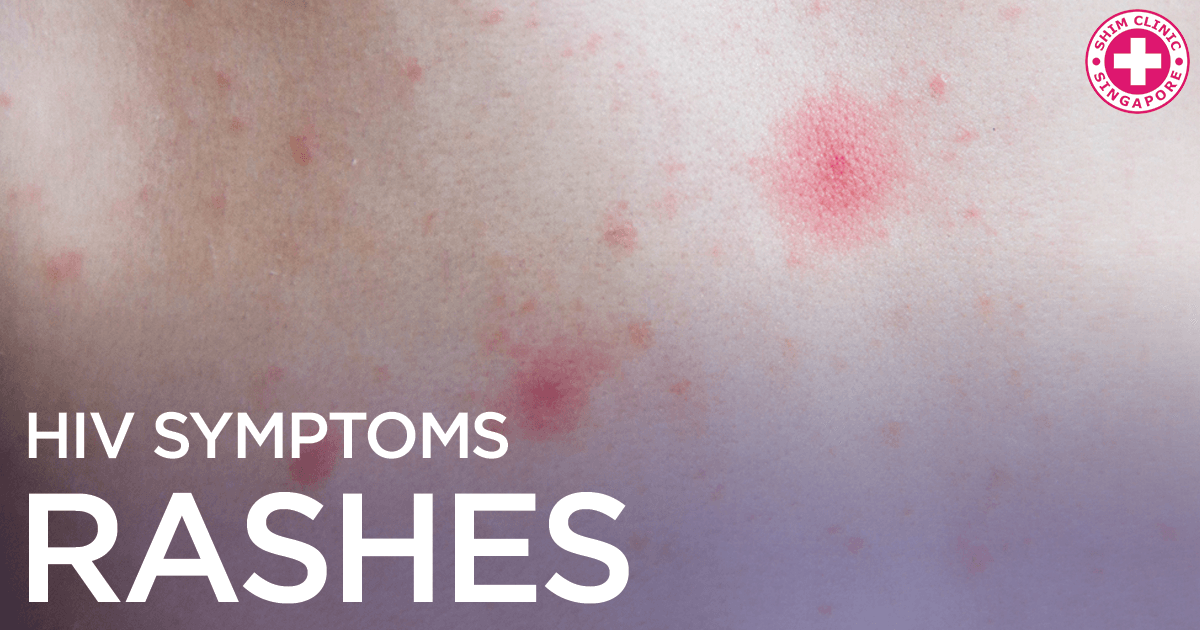HIV Rash Singapore | Shim Clinic
| Help me about HIV Rash ! |

| Permalink: https://shimclinic.sg/hiv-rash |
A rash is a possible symptom of an acute HIV infection. The rash consists of many small spots, flat or slightly raised, present on the torso, face, palms of the hands, and sometimes other parts of the body. This rash is typically not itchy. To find out whether it’s due to HIV, you need an HIV test.
A rash is a possible symptom of an acute HIV infection. Also known as primary HIV infection or seroconversion illness, these are the symptoms that occur when someone first acquires HIV. The symptoms don’t begin right away, but instead start 2 to 4 weeks after the exposure to HIV occurred. They can then last for up to a few weeks. After they resolve, the HIV infection will not be gone. The virus will remain inside of the body, but will cause no more symptoms for years, until it has damaged the immune system significantly.
The skin rash associated with acute HIV infection usually consists of many small spots, which can be flat or slightly raised. On lighter skin, they appear pink or red, while on darker skin, they may look purple or black. The rash typically appears on the torso (including the chest, abdomen, and back) and on the face, and may also affect the palms of the hands. It can appear on other parts of the body. This skin rash is typically not itchy.
- A rash is a possible symptom of the early phase of HIV infection (called acute HIV infection).
- It consists of small spots, which are not itchy, present on the torso, face, palms of the hands, and sometimes other parts of the body.
- The rash and other HIV symptoms resolve in a few weeks, but that doesn’t mean that the HIV infection is gone. It won’t cause symptoms for a few more years.
- There are also many other possible causes of a rash, so an HIV test is needed to verify that the rash is due to HIV.
- It’s best to visit your doctor as soon as possible after you’re exposed to HIV, rather than waiting for a rash and other symptoms, because you might be able to take HIV PEP, which can decrease your risk of getting HIV.
There are many other possible causes of a rash. Many common viral infections can cause a similar rash. Conditions like eczema and psoriasis can also cause skin rashes, although these are typically itchy, unlike the HIV rash. Even cancers like leukemia can cause a skin rash. It’s difficult to tell that the rash is actually one of your HIV symptoms just from looking at the rash, so your doctor needs to do an HIV test to know that it’s due to acute HIV infection.
Although the rash and other HIV symptoms don’t appear for 2 to 4 weeks after you’re exposed, it’s best to go to an STD clinic sooner than that, if you have a known or suspected exposure to HIV. There is a medication regimen called HIV PEP that decreases the risk of getting HIV from the exposure. However, HIV PEP loses effectiveness with every hour you wait to start it, and it’s completely ineffective if started more than 72 hours (3 days) after you’re exposed to HIV. If you wait until you have a rash and other HIV symptoms, it will be too late. Visit an STD clinic as soon as possible if a condom breaks or leaks or if you have another exposure to HIV, so you can discuss whether you’re a candidate for HIV PEP. You’ll also get an HIV test and any other STD testing you may need.
Sources:
Mayo Clinic. “STD symptoms: Common STDs and their symptoms.” Mayo Clinic. Published 18 Mar 2015. Accessed 20 Jul 2016. http://www.mayoclinic.org/std-symptoms/art-20047081
Centers for Disease Control and Prevention. “Screening Recommendations Referenced in Treatment Guidelines and Original Recommendation Sources.” Centers for Disease Control and Prevention. Published 04 Jun 2015. Accessed 20 Jul 2016. http://www.cdc.gov/std/tg2015/screening-recommendations.htm
Centers for Disease Control and Prevention. “HIV/AIDS.” Centers for Disease Control and Prevention. Published 05 Jul 2016. Accessed 27 Jul 2016. http://www.cdc.gov/hiv/
Centers for Disease Control and Prevention. “HIV Basics – Testing.” Centers for Disease Control and Prevention. Published 12 Jul 2016. Accessed 20 Jul 2016. http://www.cdc.gov/hiv/basics/testing.html
U.S. Department of Health & Human Services. “Post-Exposure Prophylaxis (PEP).” AIDS.gov. Published 21 Sep 2015. Accessed 20 Jul 2016. https://www.aids.gov/hiv-aids-basics/prevention/reduce-your-risk/post-exposure-prophylaxis/
| Timeline | HIV | STD | Pregnancy |
|---|---|---|---|
| Before exposure | |||
| Contraception (females only) | |||
| HIV PrEP (pre-exposure prophylaxis) - Stop HIV infection before exposure | STD vaccine: - Hepatitis vaccine - HPV vaccine | ||
| STD / HIV exposure | |||
| 0-72 hours | HIV PEP (post-exposure prophylaxis) - Stop HIV infection after exposure | STD testing * - Screening test - to look for asymptomatic infections - from previous exposures | Emergency contraception with the morning-after pill (females only) |
| 2 weeks | HIV DNA Test | ||
| 1 month | HIV 4th Generation Test - SD Bioline HIV Ag/Ab Combo - Fingerprick blood sampling. - 20 minutes to results | ||
| 3 months | HIV 3rd Generation Test - OraQuick® HIV-1/2 Antibody - Oral fluid or - Fingerprick blood sampling. - 20 minutes to results | STD testing * - Full & comprehensive - diagnostic test - to look for current infections | |
| Watch for | HIV Symptoms | STD Symptoms | |
| If infected | HIV Treatment | STD Treatment | Abortion |
References